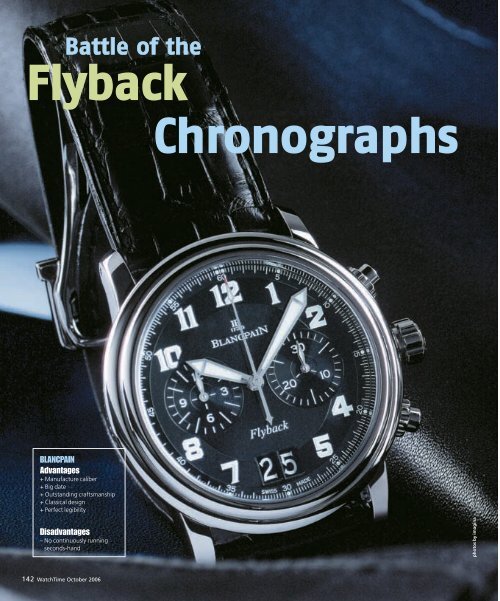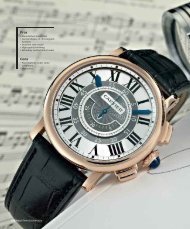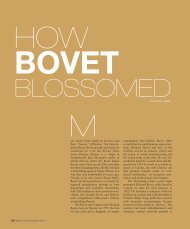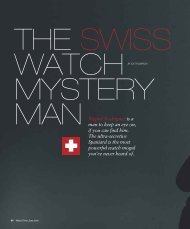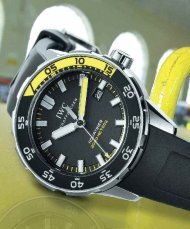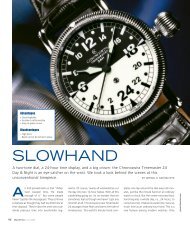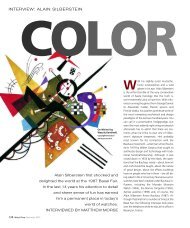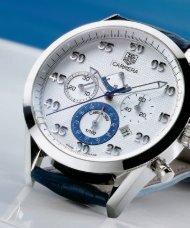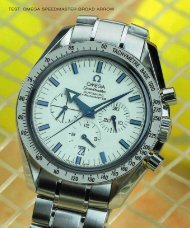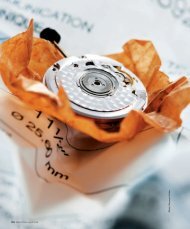WT_2006_05: COMPARATIVE TEST BLANCPAIN AND PANERAI
WT_2006_05: COMPARATIVE TEST BLANCPAIN AND PANERAI
WT_2006_05: COMPARATIVE TEST BLANCPAIN AND PANERAI
Create successful ePaper yourself
Turn your PDF publications into a flip-book with our unique Google optimized e-Paper software.
Battle of the<br />
Flyback<br />
Chronographs<br />
<strong>BLANCPAIN</strong><br />
Advantages<br />
+ Manufacture caliber<br />
+ Big date<br />
+ Outstanding craftsmanship<br />
+ Classical design<br />
+ Perfect legibility<br />
Disadvantages<br />
– No continuously running<br />
seconds-hand<br />
photos by imagina<br />
142 WatchTime October <strong>2006</strong>
<strong>PANERAI</strong><br />
Advantages<br />
+ Successful design<br />
+ Outstanding craftsmanship<br />
+ Good legibility<br />
Disadvantages<br />
– No date display<br />
– Movement based on a<br />
mass-produced caliber<br />
October <strong>2006</strong> WatchTime 143
Fine movement: with a column-wheel, vertical<br />
coupling and a big date display, the 69FB has plenty<br />
to offer both visually and technically.<br />
Like an airplane that aborts a landing before ascending again, a flyback chronograph can return<br />
its hands to zero before starting to measure another interval. We compare and contrast<br />
the merits of two favorites in the category: Blancpain’s Léman Flyback Big Date and Panerai’s<br />
Luminor 1950 Chrono Flyback.<br />
BY JENS KOCH<br />
The term “flyback” doesn’t really<br />
have much to do with flying. It refers<br />
to the hands on a watch that measure<br />
elapsed intervals and will, at one push of a<br />
button, “fly back” to their starting positions<br />
and resume their motion from there. Aviators,<br />
however, were very grateful for this invention.<br />
Prior to a flight, they must calculate estimated<br />
time intervals — from the airstrip to a distinctive<br />
feature in the landscape, and from one successive<br />
landmark to the next — and enter this information<br />
into a flight plan. Immediately after<br />
takeoff, they switch on the chronograph mechanism,<br />
and periodically refer to its minute<br />
counter to see how long they’ve been flying between<br />
each selected landmark. If the elapsed<br />
time indicates that the aircraft will soon fly over<br />
one of them, pilots keep their eyes peeled for it.<br />
As the airplane flies over it, they press the flyback<br />
button once, returning the elapsed-time<br />
hands to their starting positions, and begin<br />
measuring the time until the next landmark.<br />
The flyback function makes life easier in a<br />
cockpit in several ways. Pilots typically have<br />
their hands full with in-flight jobs, like keeping<br />
the plane at its correct altitude and on its proper<br />
course, monitoring instruments and radio<br />
transmissions, and keeping a watchful eye on<br />
other aircraft in the vicinity. They also must enter<br />
into the flight plan the time when their<br />
plane flies over each landmark. A flyback chronograph<br />
eliminates the need for two manually<br />
executed tasks and eases a pilot’s workload,<br />
while increasing the safety of his passengers, by<br />
pre-empting two potential sources of human<br />
error. If he’s wearing an ordinary (non-flyback)<br />
chronograph and doesn’t press forcefully<br />
enough (regardless of whether his intention is<br />
to stop the chronograph, return its hands to<br />
zero or restart them), his wristwatch won’t indicate<br />
the correct elapsed flight time.<br />
The flyback function is obviously useful in an<br />
airplane’s cockpit, but what about outside the<br />
aircraft and on terra firma Blancpain’s Léman<br />
Flyback Big Date and Panerai’s Luminor 1950<br />
Chrono Flyback wristwatches are two examples<br />
that are well-designed and very distinct stylistically<br />
from each other. Each strives for sporty el-<br />
144 WatchTime October <strong>2006</strong>
It runs and runs and runs: the ETA Valjoux 7750 gets its<br />
flyback mechanism from La Joux-Perret and its embellishments<br />
from Panerai.<br />
Each movement suits the character of its case: the Panerai chronograph relies on a robust<br />
Valjoux 7750 as its basic movement; Blancpain uses a fine Caliber 1185 originally developed<br />
by its sister firm, Frédéric Piguet.<br />
egance, but sets its own priorities in the pursuit.The<br />
Blancpain is classically elegant, slim<br />
and reserved, with the bold numerals that typically<br />
distinguish Blancpain’s pilots’ watches.<br />
Blancpain’s customary sporty design touches<br />
are also evident, though this watch is not intended<br />
for a wearer who breaks much of a<br />
sweat while playing his favorite sport.<br />
Panerai’s styling is decidedly less understated,<br />
but also displays some subtlety. The Luminor<br />
Flyback 1950 looks smaller than its enormous<br />
44-mm-diameter case would lead you to<br />
expect, but its highly domed crystal, prominent<br />
crown-protector bow and distinctively styled<br />
dial command attention. Unlike Blancpain’s<br />
watch, the Panerai model emphasizes the<br />
sporty aspects, while still managing to convey<br />
elegance through the traditional styling of its<br />
case and dial. The Luminor also looks more<br />
modern than the Léman thanks to the hightech<br />
design of Panerai’s crown protector and<br />
the old-fashioned typeface used for Blancpain’s<br />
numerals. Panerai’s choice of strap — calfskin<br />
with embossed carbon-fiber pattern — also accentuates<br />
the watch’s contemporary feel, and<br />
contrasts with Blancpain’s more traditional<br />
crocodile-skin strap. The Luminor’s gift box also<br />
includes a replacement rubber strap.<br />
Both timepieces look great with a business<br />
suit. The Blancpain suggests that its wearer<br />
probably owns the classical English sportscar<br />
parked in front of the door, while the Panerai<br />
watch hints that its wearer is more likely holding<br />
the keys to the high-end SUV. There is also<br />
a contrast in the watches’ sizes and weights:<br />
the Léman is an understated 40 millimeters in<br />
diameter and weighs just 86.5 grams; Panerai’s<br />
44-mm colossus weighs a hefty 151<br />
grams, and is nearly half a centimeter thicker<br />
than the Léman. Of course, the Luminor’s<br />
larger dimensions are no surprise to watch<br />
history buffs. Panerai traces its roots to the<br />
1930s, making its name developing highly<br />
functional and robust wrist-borne itimepieces<br />
for Italian naval frogmen.<br />
When it comes to operation, these watches<br />
have much in common. Both chronographs can<br />
be started and stopped by pressing the button<br />
at the 2, and the hands that clock elapsed intervals<br />
can be returned to their starting positions<br />
by pressing the button at the 4. If the chronograph<br />
is already switched on when this latter<br />
button is pressed, then the moment it’s released,<br />
the elapsed-time hands will resume<br />
their motion and the chronograph will begin to<br />
measure the duration of the next interval. The<br />
crown of each watch can be used to set the<br />
146 WatchTime October <strong>2006</strong>
In profile: Blancpain offers an excellently crafted case with threaded push-pieces.<br />
time; Blancpain’s crown is also used to reset its<br />
date display, which the Panerai model lacks. The<br />
crown and push-pieces on the Léman must first<br />
be unscrewed before they’re operated; the Luminor’s<br />
hinged crown-protection bow must first<br />
be flipped open before the time can be reset.<br />
The advantages of Blancpain’s threaded pushpieces<br />
are that they help make the slim case water-resistant<br />
to a greater depth (100 meters)<br />
and, if the case is wet, they protect it against the<br />
penetration by water which might occur if the<br />
buttons were inadvertently pressed. In their unscrewed<br />
positions, the top surfaces of the pushpieces<br />
are enlarged by their knurled bolts.<br />
Along with their already slight resistance, this<br />
makes the buttons easy to operate.<br />
Panerai lags behind in this category. Though<br />
the absence of threading on the Luminor’s pushpieces<br />
means that these buttons are always instantly<br />
operable, you need to apply plenty of fingertip<br />
pressure to trigger them; the return-tozero<br />
flyback button at the 4 is particularly stubborn.<br />
The comparatively small area of the top<br />
surfaces of these buttons means that they can’t<br />
compensate for their stiffness by allowing the<br />
user to distribute the pressure over a larger area.<br />
The lower button is particularly hard to push because<br />
the crown protector gets in the way.<br />
As far as setting the time, Panerai outdoes<br />
Blancpain because the Luminor is<br />
equipped with a stop-seconds function. This<br />
feature is absent on the Léman, which also<br />
lacks a continuously running seconds-hand.<br />
On the other hand, the 12-hour counter on<br />
Blancpain’s watch can tally much longer<br />
elapsed intervals than Panerai’s 30-minute<br />
counter. A much more important and genuinely<br />
functional advantage is that Blancpain’s<br />
Flyback has a big date display (Blancpain<br />
also offers a model with an ordinary<br />
date display and a continuously running seconds-hand<br />
on a subdial at the 6). After all, a<br />
date display is one of the most frequently<br />
used additional functions. Blancpain’s big<br />
date indicator, harmoniously integrated into<br />
the dial at the 6, is appealingly unobtrusive<br />
because the date disks match the color<br />
scheme of the rest of the dial: white digits<br />
against a black background. Each of the<br />
date’s two digits occupies its own plane, but<br />
the difference in their heights is nearly unnoticeable<br />
and the date remains easily legible,<br />
even viewed from a difficult angle. If the<br />
watch has gone unused for a few days or<br />
weeks, a rapid adjustment mechanism can<br />
easily reset the date.<br />
DATA<br />
<strong>BLANCPAIN</strong> LÉMAN FLYBACK<br />
CHRONOGRAPH<br />
Manufacturer: Blancpain SA, Chemin de<br />
l’Etang 6, CH-1094 Paudex, Switzerland<br />
Model: Léman Flyback Big Date<br />
Reference number: 717.040K-00<br />
Functions: Hours, minutes, seconds, flyback<br />
chronograph with counters for the seconds,<br />
30 minutes and 12 hours; big date<br />
Movement: Self-winding Caliber 69F8, based<br />
on Caliber F185; diameter = 32 mm;<br />
height = 7 mm; 21,600 vph; 42 jewels; chronograph<br />
controlled via column-wheel; vertical<br />
coupling; Kif shock absorption; fine adjustment<br />
via micrometer screw; about 38-hour power<br />
reserve<br />
Case: Steel case; sapphire crystal is nonreflective<br />
on both its surfaces; threaded back with sapphire<br />
crystal window; water-resistant to 100 meters<br />
Strap and clasp: Crocodile-skin strap with<br />
folding clasp<br />
Rate Test:<br />
(Deviations in seconds per 24 hours)<br />
With and without chronograph switched on<br />
Dial up: 0 +1<br />
Dial down: 0 0<br />
Crown up: +1 +1<br />
Crown down: -1 -3<br />
Crown left: -4 0<br />
Crown right: +6 +6<br />
Greatest deviation of rate: 10 9<br />
Mean deviation: +0.3 +0.8<br />
Mean amplitude<br />
flat positions: 316° 3<strong>05</strong>°<br />
hanging positions: 275° 264°<br />
Dimensions: Diameter = 40 mm,<br />
height = 14.2 mm; weight = 86.5 grams.<br />
Price: $12,000<br />
Attractively packaged: both wristwatches<br />
come in beautiful wooden boxes. Panerai’s<br />
chronograph includes an extra strap and a<br />
special tool to help you switch.<br />
148 WatchTime October <strong>2006</strong>
<strong>COMPARATIVE</strong> <strong>TEST</strong>: <strong>BLANCPAIN</strong> <strong>AND</strong> <strong>PANERAI</strong><br />
Both wristwatches fit so comfortably on the forearm that you can almost forget you’re wearing<br />
them. Panerai’s heavy weight will occasionally remind you.<br />
Light the Night<br />
A thick layer of luminous material on the Blancpain’s<br />
hands and numerals assures that the<br />
time will be easily readable at nighttime or in<br />
the dark. The luminescent strips on the Panerai’s<br />
hands are slender in comparison, but just<br />
as legible. The competing timepieces fought to<br />
a tie in the “legibility of elapsed time” category.<br />
Panerai coats the three main minute indices<br />
with luminous material, and the red tip on<br />
Blancpain’s elapsed seconds-hand makes it<br />
somewhat easier to find in the dark than its<br />
counterpart on the Panerai.<br />
We were slightly disappointed to find that<br />
the fractions-of-seconds strokes on Blancpain’s<br />
dial are incorrectly calibrated. The balance<br />
oscillates at a rate of 21,600 vibrations<br />
per hour, so the seconds-hand necessarily progresses<br />
through six increments each second. It<br />
would have made more sense to put six (or at<br />
least three) subdivisions between each pair of<br />
full-second strokes, rather than the illogical<br />
four that Blancpain chose. Panerai’s designers<br />
found a better solution. The balance in Panerai’s<br />
movement oscillates faster, completing<br />
28,800 vibrations per hour, so the seconds<br />
hand accordingly advances through eight increments<br />
every second. The seconds scale is<br />
marked with full seconds and half-seconds, so<br />
the seconds-hand will stop with its tip pointing<br />
exactly to a stroke whenever it has been<br />
halted — either four or eight eighths-of-a-second<br />
after the previous full second. Panerai’s<br />
watch has a tachymeter scale that lets you<br />
read average speeds directly from the dial: to<br />
use it, simply measure the time that has<br />
elapsed between two consecutive mile markers<br />
along the highway.<br />
Comparing the fine details, we found that<br />
Blancpain’s case is more finely crafted than Panerai’s,<br />
with impressive detail on the more<br />
Distinctive: Panerai’s watch has the typical crown protector and a cleverly shaped satin-finished case.<br />
elaborate concave surfaces, in the underside of<br />
the horns, and in the milled brand name on the<br />
rim. This last-mentioned detail, of course, is a<br />
matter of taste.<br />
Both straps feature well-made clasps, with<br />
each perfectly matching its respective case. Panerai’s<br />
double-folding clasp with safety buttons<br />
is large, satin-finished, and eye-catching,<br />
with a high-tech look; Blancpain’s folding clasp<br />
is polished, slimmer and more rounded.<br />
DATA<br />
<strong>PANERAI</strong> LUMINOR 1950 CHRONO FLYBACK<br />
Manufacturer: Officine Panerai, Rue de la<br />
Balance 4, CH-2000 Neuchatel, Switzerland<br />
Model: Luminor 1950 Chrono Flyback 44 mm<br />
Reference number: PAM00212<br />
Functions: Hours, minutes, seconds, flyback<br />
chronograph with counters for the elapsed seconds<br />
and 30 minutes; stop-seconds mechanism<br />
Movement: Self-winding Caliber OP XIX,<br />
based on a Valjoux 7750, additional mechanism<br />
from La Joux-Perret; diameter = 30 mm;<br />
height = 8.1 mm; 28,800 vph; 30 jewels;<br />
Incabloc shock absorption; Triovis fine adjustment;<br />
COSC chronometer certificate; about 42-<br />
hour power reserve<br />
Case: Steel case; 2-mm-thick sapphire crystal is<br />
nonreflective on its inner surface; threaded back<br />
with sapphire crystal window; patented bow protects<br />
the crown; water-resistant to 100 meters<br />
Strap and clasp: Calfskin strap with carbonfiber<br />
pattern; double-folding clasp with pushpieces;<br />
a rubber strap and a tool to help<br />
change straps are included with the watch<br />
Rate Test:<br />
(Deviations in seconds per 24 hours)<br />
With and without chronograph switched on<br />
Dial up: +6 +8<br />
Dial down: +7 +6<br />
Crown up: +6 +5<br />
Crown down: +3 +4<br />
Crown left: +8 +5<br />
Crown right: +3 +3<br />
Greatest deviation of rate: 5 5<br />
Mean deviation: +5.5 +5.2<br />
Mean amplitude<br />
flat positions: 308° 285°<br />
hanging positions: 306° 265°<br />
Dimensions: Diameter = 44 mm,<br />
height = 19 mm; weight = 151 grams.<br />
Price: $8,800<br />
150 WatchTime October <strong>2006</strong>
<strong>COMPARATIVE</strong> <strong>TEST</strong>: <strong>BLANCPAIN</strong> <strong>AND</strong> <strong>PANERAI</strong><br />
Blancpain’s<br />
nonreflective<br />
crystal is almost<br />
invisible.<br />
An elegant combination: the polished folding clasp harmonizes with the crocodile-skin wristband.<br />
Our two contestants also battled to a stalemate<br />
in the “wearing comfort” category. Their<br />
supple straps, with ideally positioned clasps on<br />
the wrist, almost made us forget that we were<br />
wearing them. Of course, the greater weight<br />
of Panerai’s chronograph will remind you of its<br />
presence, and its larger size makes it more likely<br />
to bump into surrounding objects. Both<br />
watches boast unusual straps: Panerai opts for<br />
a cowhide wristband with a modern, carbonfiber<br />
look; Blancpain’s timepiece sports a crocodile-skin<br />
strap with a layer of rubber on its inner<br />
surface, which makes it less susceptible to<br />
the ill effects of perspiration. Panerai,<br />
renowned for its diver’s watches, includes an<br />
additional rubber strap in its hardwood gift<br />
box, allowing the wearer the option of replacing<br />
the strap for amphibious timekeeping.<br />
A Contrast in Calibers<br />
Both watches offer a pane of sapphire crystal in<br />
the back of their cases, so aficionados can enjoy<br />
views of the movements. Each movement suits<br />
the character of its respective case: The Panerai<br />
chronograph relies on a robust Valjoux 7750 as<br />
its basic movement; Blancpain uses a fine Caliber<br />
1185, which was originally developed by this<br />
manufacture’s sister firm Frédéric Piguet.<br />
Caliber 69F8 with flyback and big date is<br />
available only from Blancpain. The Luminor Flyback<br />
1950 gets its flyback from the mechanism<br />
specialists at La Joux-Perret (formerly Jaquet).<br />
Panerai adds the embellishments on its own<br />
premises. Replete with flyback mechanism and<br />
Panerai’s own decorations, the movement is<br />
designated as Caliber OP XIX.<br />
It’s not a simple task to add a flyback mechanism<br />
to a chronograph movement. Ordinarily,<br />
only the upper push-piece causes the propelling<br />
wheel to mesh with the chronograph mechanism<br />
and the lower return-to-zero button is only<br />
operable when the chronograph is motionless.<br />
The situation is different for flyback chronographs:<br />
while the chronograph is still running,<br />
pressure on the lower button first uncouples the<br />
propelling wheel before the hand returns to<br />
zero. Without this step, the wheels could suffer<br />
damage. Additional levers must be integrated to<br />
accomplish the necessary tasks.<br />
When our competitors’ movements were<br />
compared one-on-one, Blancpain clearly<br />
emerged victorious. The construction with a column-wheel<br />
and vertical coupling is finer, more<br />
sensible, more functional and more laborious to<br />
manufacture. Compared to the cam switching<br />
in Panerai’s movement, Blancpain’s construction<br />
guarantees that its chronograph’s seconds hand<br />
begins to move without a shudder or jump and<br />
that its push-pieces are smoothly operable without<br />
excessive force. This type of construction<br />
also results in a more attractive overall look for<br />
the movement. The Valjoux 7750, with its wire<br />
springs and embossed components, cannot<br />
<strong>TEST</strong> RESULTS<br />
<strong>BLANCPAIN</strong> LÉMAN FLYBACK<br />
CHRONOGRAPH<br />
Strap and clasp (max. 10 points): The crocodile-skin<br />
strap with rubber on its inner surface<br />
is just as neatly crafted as the stable, polished,<br />
folding clasp. 9<br />
Operation (5): The push-pieces and crown are<br />
threaded, but very easy to operate. A rapid adjustment<br />
mechanism makes resetting the date<br />
display easy. 5<br />
Case (10): An elegant and very beautifully<br />
made case. Refined details such as the brand’s<br />
name on the flank testify to Blancpain’s attention<br />
to detail. 9<br />
Design (15): Very successful, sporty elegance.<br />
All elements harmonize with one another. 13<br />
Legibility (5): Large luminous numerals and<br />
hands assure that the time is easily read, even<br />
at night. 5<br />
Wearing comfort (10): Thanks to its supple<br />
strap and comparatively low overall weight, you<br />
almost forget you’re wearing it. 10<br />
Movement (20): A fine movement that combines<br />
functional refinement with attractive embellishments.<br />
17<br />
Rate results (10): Very slight average deviation,<br />
but large differences among the several<br />
positions. 7<br />
Overall rating (15): The higher price is justified<br />
by this watch’s high quality and superlative<br />
functioning. 13<br />
TOTAL:<br />
88 points<br />
conceal the fact that its developers designed it<br />
so that it could be produced less expensively<br />
than a comparable column-wheel chronograph<br />
movement, but Panerai makes the best of the<br />
situation. The rotor and the bridge for the selfwinding<br />
mechanism are adorned with Geneva<br />
waves; blued screws are used in the movement;<br />
and the plates are embellished with circular<br />
graining. The results are very attractive, but<br />
Blancpain’s decorative touches are even finer: its<br />
flat parts have beveled and polished edges. Oth-<br />
152 WatchTime October <strong>2006</strong>
<strong>COMPARATIVE</strong> <strong>TEST</strong> <strong>BLANCPAIN</strong> <strong>AND</strong> <strong>PANERAI</strong><br />
Panerai’s eye-catching,<br />
highly domed crystal.<br />
The satin-finished, double-folding clasp with safety buttons iworks well on Panerai’s watch.<br />
er notable details include the fine adjustment<br />
mechanism, the way the balance-spring is attached,<br />
and the milled levers.<br />
Accuracy and Value<br />
Of course, the accuracy of a watch’s rate is always<br />
a key factor. Can Panerai’s tractor outdo<br />
Blancpain’s sportscar in this category It can,<br />
and does. Both movements ran very well, but<br />
when they went one-on-one on our timing machine,<br />
the Panerai powerhouse came out ahead<br />
in the most important category: maximum deviation<br />
among the several positions. This value remained<br />
at five seconds, both with and without<br />
the chronograph switched on. Blancpain’s<br />
watch had a wider spread and deviated by 10<br />
seconds with the chronograph switched off and<br />
by 9 seconds with the stopwatch function<br />
switched on. The Léman had been adjusted to<br />
gain slightly, so in our test it failed to keep time<br />
with the accuracy that it would need to earn it<br />
chronometer certification. Still, Blancpain’s<br />
watch posted values very close to the zero mark<br />
in all of the various positions, and performed<br />
with a respectable average deviation of +0.3<br />
seconds per day. On the other hand, there’s really<br />
no reason to complain about the Luminor’s average<br />
daily deviation of 5.5 seconds.<br />
Furthermore, Panerai’s flyback chronograph<br />
is significantly less expensive than Blancpain’s<br />
model: the former retails for $8,800, the latter<br />
for $12,000. Essentially, A few bucks more<br />
buys you the big date display on Blancpain’s<br />
watch, while Panerai is kinder to your wallet,<br />
but keeps you in the dark about the date. If you<br />
can do without a date display (but don’t want<br />
to forego it altogether), then you might be interested<br />
in Blancpain’s Flyback without big<br />
date. This model resembles the Léman with big<br />
date, but its overall diameter is three millimeters<br />
smaller. It makes do without a viewing<br />
window in the back and it sells for just $9,800<br />
— a price more or less on a par with that of the<br />
Panerai Luminor 1950 Chrono Flyback.<br />
Crunching the numbers again will show that<br />
Blancpain levies a surcharge of $2,200 for the<br />
big date display. But that’s really not exorbitant,<br />
especially when you consider that the surcharge<br />
also buys you a pane of sapphire crystal<br />
in the back. And you probably won’t want to<br />
do without the viewing window simply because<br />
it’s so much fun to peer through the<br />
pane and watch the gorgeously decorated<br />
movement do its tricks.<br />
Ultimately, it’s the finer and more elaborately<br />
constructed movement that edges the Blancpain<br />
timepiece into the winners circle. However,<br />
<strong>TEST</strong> RESULTS<br />
<strong>PANERAI</strong> LUMINOR 1950 CHRONO FLYBACK<br />
Strap and clasp (max. 10 points): An interesting<br />
embossed carbon-fiber pattern adorns<br />
the leather strap. The clasp is robust and secure.<br />
8<br />
Operation (5): The push-pieces don’t run quite<br />
as smoothly as Blancpain’s buttons, but are<br />
good nonetheless. 4<br />
Case (10): The satin-finished and pillow-shaped<br />
case is well crafted, with elaborate protection<br />
for the crown and screwed strap lugs. 9<br />
Design (15): Panerai’s typical styling has been<br />
successfully modified for a chronograph wristwatch,<br />
but the hands are too short. 13<br />
Legibility (5): Unmistakable luminous indices<br />
and two large numerals help keep you oriented<br />
on the dial, although the black hands would<br />
have benefited from a bit more luminous material.<br />
5<br />
Wearing comfort (10): Panerai’s watch is very<br />
comfortable to wear, despite its heavy weight<br />
and large dimensions. 9<br />
Movement (20): The reliable but mass-produced<br />
Valjoux 7750 has been given a flyback<br />
mechanism and elaborate decorations. 14<br />
Rate results (10): Very slight deviation among<br />
the several positions, but the timepiece gains<br />
more strongly than a chronometer should. 8<br />
Overall rating (15): Except for the movement,<br />
you get a very solid product for your money. 12<br />
TOTAL:<br />
82 points<br />
if you can do without a date display, the Panerai<br />
Luminor 1950 Chrono Flyback is a worthy<br />
purchase as well. The quality of both watches is<br />
very high, and the price of each is fully appropriate<br />
to the level of quality. Ultimately, your purchasing<br />
decision will probably be most strongly<br />
influenced by the disparate characters of these<br />
two timepieces. Whether you opt for the gentleman<br />
or the adventurer, each flyback chronograph<br />
wristwatch underscores its wearer’s personality<br />
quite admirably.<br />
■<br />
154 WatchTime October <strong>2006</strong>


